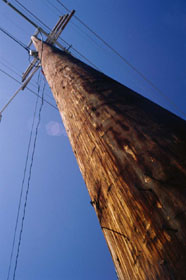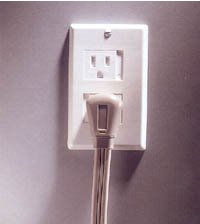Electrocution: The Six Top Danger Points and How to Avoid Them
by www.SixWise.com
When you think of things that are strong conductors of electricity, power lines, wires and metals likely come to mind. Surprisingly, the human body can also be an excellent electricity conductor, and when electric currents hit the body several types of injuries may occur.
|

Don't let ladders or objects touch power line wires--and never go near fallen wires for any reason! |
The body may go into cardiac arrest because of the electricity's effect on the heart; muscle, nerves and tissue can be damaged due to the current; or thermal burns can occur if the body contacts an electrical source.
The severity of the injuries depends on a variety of factors (the voltage of electricity, the person's state of health, how the current travels through the body and how quickly medical help is received), but, according to the National Institutes of Health, some 1,000 people die in the United States each year because of electric shock.
Fortunately, you and your loved ones can dramatically reduce the risks if you are aware of top electrocution threats in and around your home and take the simple measures to prevent them:
1. Extension cords. These handy tools can cause electrical burns and shock if they're not used carefully. Cords that have exposed wires should never be used, as kids and pets can (and will) chew on them if they can get them. In fact, electrical burns to the mouth account for half of the extension-cord-related injuries to young children, according to the U.S. Consumer Product Safety Commission (CPSC).
Even an intact exten
When you think of things that are strong conductors of electricity,
power lines, wires and metals likely come to mind. Surprisingly,
the human body can also be an excellent electricity conductor,
and when electric currents hit the body several types of injuries
may occur.
|

Don't let ladders or objects touch power line wires--and
never go near fallen wires for any reason!
|
The body may go into cardiac arrest because of the electricity's
effect on the heart; muscle, nerves and tissue can be damaged
due to the current; or thermal burns can occur if the body
contacts an electrical source.
The severity of the injuries depends on a variety of factors
(the voltage of electricity, the person's state of health,
how the current travels through the body and how quickly medical
help is received), but, according to the National Institutes
of Health, some 1,000 people die in the United States each
year because of electric shock.
Fortunately, you and your loved ones can dramatically reduce
the risks if you are aware of top electrocution threats in
and around your home and take the simple measures to prevent
them:
1. Extension
cords. These handy tools can cause electrical burns
and shock if they're not used carefully. Cords that have exposed
wires should never be used, as kids and pets can (and will)
chew on them if they can get them. In fact, electrical
burns to the mouth account for half of the extension-cord-related
injuries to young children, according to the U.S. Consumer
Product Safety Commission (CPSC).
Even an intact extension cord poses a risk. For instance,
in one case a 15-month-old girl put an extension cord in her
mouth and suffered electrical burns that required surgery.
To reduce the risks, keep extension cords out of reach of
kids and pets, and always purchase cords that have the UL
and OSHA labels on them (these cords have been subjected to
strict tests to ensure they meet certain safety standards).
Further, use common sense measures to be sure the cords are
in good shape, including:
-
Inspect them regularly for signs of wear and tear.
-
Replace old extension cords that are cracked or frayed.
-
Only use exterior extension cords for outside use.
-
Don't overload cords or sockets.
-
Pull the plug, not the cord, when disconnecting it from
the socket
-
Only use extension cords when they're absolutely necessary,
and try not to use them for long-term purposes.
2. Electrical outlets. Most electrical outlets are
located in areas of the home that children can easily reach.
Close to 4,000 injuries associated with
electrical outlets are treated in U.S. emergency rooms every
year, says the CPSC, and about one-third of these occur
when kids looking to explore insert metal objects like keys
and hairpins into the outlets.
|
Six Things NOT to Do to an Electrocution
Victim
If you are with someone who is electrocuted, here is
what NOT to do, according to the National Institutes
of Health:
-
DO NOT touch the victim with your bare hands if
the person is still in contact with the source of
electricity.
-
DO NOT remove dead skin or break blisters if the
person is burned.
-
DO NOT apply ice, butter, ointments, medications,
fluffy cotton dressings, or adhesive bandages to
a burn.
-
DO NOT touch the skin of someone who is being electrocuted.
-
DO NOT get within 20 feet of someone who is being
electrocuted by high-voltage electrical current
until the power is turned off.
-
DO NOT move a victim of electrical injury unless
there is immediate danger.
|
Since you can't move your outlets away from your kids, it's
imperative to cover your outlets with the Sliding
Decora Outlet Cover (for outlet covers requiring two screws,
as in most newer homes) or the Standard
Sliding Outlet Cover (for outlet covers requiring only
one screw in the middle, as in most older homes.)
If you routinely have kids in your home, check out these
simple, inexpensive but ingenious outlet
covers by clicking on either link above! These easy-to-install
outlet covers are spring activated, so they automatically
cover outlets when any plug is removed. This means
kids can't insert objects or fingers
into the outlets at any time!
It's important to only insert appropriate plugs into electrical
outlets (any other object poses an electrocution danger) and
use caution when you do, such as being careful not to touch
the metal prongs when inserting the plug.
3. Electric appliances. We become so accustomed to
using electric appliances in our daily lives that it's easy
to become careless with their use. This is often when electrocution
can occur. Even touching an electric appliance like a hair
dryer with wet hands can cause a shock. Here are some other
safety tips to keep safe around electric appliances:
-
Don't use electric appliances near water or while touching
faucets or water pipes.
-
Don't use appliances that have worn plugs or cracked
wires.
-
Don't attempt to fix electrical appliances on your own,
even if it appears simple.
-
Unplug appliances when they're not in use.
4. Swimming Pools, Hot Tubs, Spas. The common risk
that comes along with swimming pools and hot tubs is drowning,
but the American Red Cross points out another, often overlooked,
risk -- electrocution. According to CPSC, the biggest risks
of electrocution here come from faulty underwater lighting,
aging electrical wiring, sump pumps, power washers and vacuums
that are not grounded, and electrical appliances and extension
cords that fall into the water. The risk
is especially apparent if lighting and circuits aren't protected
by Ground-Fault Circuit-Interrupters (GFCIs), which
are one of the best ways to prevent electrocution, CPSC says.
According to Hal Stratton of CPSC, "The best protection
for families is inspection, detection, and correction of electrical
hazards in and around swimming pools, hot tubs and spas. CPSC
strongly encourages residential and commercial pool owners
and operators to upgrade protection of the lights, receptacles,
and switches with GFCIs. Older pools are the biggest concern,
as underwater lighting fixtures may have degraded with age
and may not be protected by GFCIs."
|

If you're caught in a lightning storm, never
seek shelter under a tree or other tall object.
|
5. Power Lines. High-voltage overhead power lines
can pose a risk to people on ladders or other lifts. Says
Thomas Moore of CPSC, "CPSC believes that there are still
many electrocution deaths that could be prevented. Consumers
should never place a ladder, antenna, or anything else near
a power line. Consumers who come in contact with an overhead
power line may not live to share their experience."
Further, wires from a downed power line can also be deadly.
Never go near a power line that is down, such as after a storm,
as live wires can be present long after the pole falls (until
the electricity has been turned off). People have also died
after striking an electrical pole in a car accident and having
the live wires touch the car.
6. Lightning. Lightning and thunderstorms are most
likely to occur on hot and humid days. If you sense a storm
approaching, seek shelter indoors immediately, as lightning
can cause serious injury, particularly to those who are stranded
outside without proper protection. According to Dawna L. Cyr
and Steven B. Johnson, Ph.D. from the University of Maine,
lightning can injure or kill people
in five ways:
-
Through a direct strike that causes cardiac arrest or
stops breathing.
|
Protect Your Family from Electric
Shock Dangers with the Top-Recommended & Economical
Sliding Outlet Covers!

Children and pets risk electrocution from exposed
outlets in your home. Of the nearly 4,000 injuries
from electrical outlets that are treated in U.S. emergency
rooms every year, one-third occur when kids looking
to explore insert metal objects like keys and hairpins
into the outlets.
The Sliding
Decora Outlet Cover and the Sliding
Standard Outlet Cover offer exceptional protection
at an affordable price:
-
The simple-to-install outlet cover is spring
activated, so it automatically covers outlets
when any plug is removed.
-
Includes an energy-saving gasket to protect from
air drafts.
-
The Sliding
Decora Outlet Cover is for newer outlets that
attach with two screws, one on either end, of
the outlet.
-
If you have an older-type outlet with one screw
in the middle, choose the Standard
Outlet Cover.
Read
More About the Ingenious & Economical
Sliding Decora Outlet Cover Now!
|
-
A side-flash, in which the body acts as an alternate
or parallel path for the current to reach the ground.
If the current passes through the head or heart it can
be deadly.
-
Current from a lightning flash, ranging from tingling
shock to a massive current, can be diverted from a poorly
grounded electric power pole through a wiring system.
-
Step voltage can radiate out through the ground from
a struck tree or pole (this kills many livestock each
year).
-
Indirectly, through fires, fallen trees or crushed cars.
During a lightning storm, avoid tall, isolated objects, don't
attempt to touch any fallen wires, and if you are struck by
lightning be sure to seek medical attention even if the injury
seems minor.
Recommended Reading
The
6 Most Dangerous Appliances in Your House
The
Top 10 Causes of Serious Burns to People and Pets in the Home
Sources
Star-Telegram.com
March 30, 2005
Electrical
outlet Safety
Extension
Cord Basics
CPSC:
Don't Swim With Shocks
University
of Maine: Lightning Safety
CPSC:
Electrocution Dangers From Overhead Power Lines
National
Library of Medicine: Electrical Injury